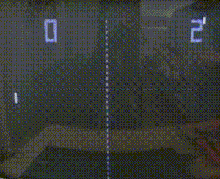User:Namcokid47/Pong-Tron
| Pong-Tron | |
|---|---|
| Developer(s) | Sega |
| Publisher(s) | Sega |
| Platform(s) | Arcade |
| Release |
|
| Genre(s) | Sports |
| Mode(s) | Single-player, multiplayer |
| Arcade system | Discrete |
Pong-Tron[a] is the first video arcade game from Sega, published in Japan in July 1973. It is a clone of Atari's Pong (1972), being created specifically for a Japanese audience. Its gameplay, simulating the sport of table tennis, is identical: players use the attached dial controllers to maneuver a paddle on the left and right-hand sides of the screen, reflecting a ball into the opponent's goal. It was programmed on discrete logic hardware, the same hardware as Pong.
Sega, at the time a producer of electro-mechanical arcade games, designed Pong-Tron to bring Pong's to Japan as a way to compete with its competitors, such as Taito.[1] It was the company's first game to utilize a CRT monitor. Pong-Tron was a commercial success and was a key factor in Sega's shift towards designing video games and home video game consoles in the 1970s and 1980s. It was followed by two sequels released the same year, Pong-Tron II and Hockey TV, which featured minimal changes.
Gameplay
[edit]
Pong-Tron simulates the sport of table tennis.[2] Players use the rotary dials on the cabinet to maneuver their respective paddles across the left or right side of the screen. The objective is to reflect a ball back and forth across the screen.[2] A point is earned when one player fails to reflect the ball and causes it to fly off their portion of the screen. The game ends when either player scores eleven points; arcade operators can adjust this to fifteen points.[3]
Development
[edit]Legacy
[edit]Notes
[edit]References
[edit]- ^ Famitsu DC Editorial Department (February 1, 2002). セガ アーケード ヒストリー [Sega Arcade History] (in Japanese). Enterbrain. ISBN 978-4757707900.
- ^ a b Horowitz, Ken (June 22, 2018). The Sega Arcade Revolution: A History in 62 Games. McFarland & Company. pp. 16–17. ISBN 978-1476672250.
- ^ Sega Pong-Tron flyer (in Japanese). Sega Enterprises. July 1973. pp. 1–4.
